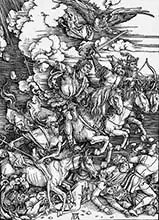About this finishing
Print. The image is printed on the top quality 10-ink HP Z9PS printer on HP matte 270 g / m2 paper. You can choose any size to an accuracy of 1 cm. A margin of 5 cm around the image is added to the size of the motif.


You can find a detailed description about our finishings
here.
The Four Horsemen of the Apocalypse
Date:
1498Medium:
woodcutLocation:
private collectionThe four horsemen of the apocalypse are known to us from the
biblical text Revelation of John, which is part of the New Testament.
Albrecht Dürer , the famous German
Renaissance artist, created a series of woodcuts on this subject around 1497-1498. It is one of his most famous works and is known for its detailed treatment and expressive expression of the apocalypse theme. In this work, Dürer depicted four horsemen representing four different apocalyptic phenomena. Each horseman is associated with one of the four rides of the apocalypse as described in the book of Revelation:
This horseman represents victory and conquest. He holds a bow and wears a crown. He has a power that allows him to rule the world. This rider symbolizes war and violence. He holds a sword and has the power to cause conflict and confrontation. This rider is known as hunger or death. It holds weight and grain, indicating famine and death due to lack of food. This rider symbolizes death and destruction. He holds an ax and riding animals follow him, representing death and the infernal realm.
Dürer painted picture The Four Horsemen of the Apocalypse in 1498. Prevailing color of this fine art print is green and its shape is portrait. This art piece is located in a private collection This image is printed on demand - you can choose material, size and finishing.
Albrecht Dürer (1471-1528). German painter whose work was produced in a period of great social movements associated with the Reformation. He represents a turning point of the German Gothic style. His creativity, vigour and sensitivity led to the creation of rich and perfect art. Contact with Italian artists allowed him to transfer inspiration from the
Renaissance style (humanism, Greco-Roman classicism, Mediterranean bright colors, etc.) to the height of the German Gothic.


